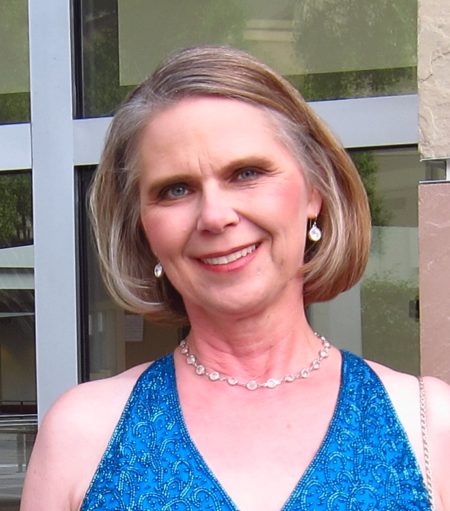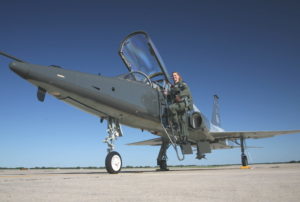Every Nov. 11 the nation observes Veterans Day, a time to pay our respects to those who have served our country in the armed forces. Here we share stories from two veterans at Berkeley Lab.
Sandra Miarecki, Lab affiliate, Nuclear Science Division and Instructor, U.S. Air Force Academy

(Photos courtesy Sandra Miarecki)
Sandra Miarecki’s military career began thanks to her lifelong dream of being an astronaut. While in college, where she majored in astrophysics, she heard that the best way to jumpstart a NASA resume was to join the military, so she signed up with the Air Force ROTC.
Commissioned in 1986, Miarecki was selected to become a pilot. Although 10 years had passed since women were permitted to enter the Air Force, she found herself in an environment that still held “very old-fashioned attitudes towards women,” as she puts it.
“I was the only woman in a class of 50 in pilot training,” Miarecki recalls. “That really toughened me; I learned that I had to just ‘give it back’ in order to earn respect.”
While health issues prevented Miarecki from fulfilling her dream of becoming an astronaut, she realized she enjoyed being a pilot and decided to stay in the Air Force. During her career, Miarecki learned to fly a variety of Air Force jets, advanced to become a flight instructor, and became a test pilot. Over the years, she flew T-37, C-141, B-52, C-5, T-38, F-15, F-16, A-10, F-18, F-4, Mig-15, T-33, and C-23 jets; helicopters; and the GoodYear Blimp.
“In my 20 years of service, attitudes toward women definitely changed, but even so, for much of my career I was the only woman in the room,” she says. “It wasn’t much of a problem until I became a test pilot, which was even more of a male-dominated, chauvinistic environment.”
 Miarecki says she encouraged herself to get through that phase with memories of all the women who’d come before her, those who had fought for the right to become pilots. “What I was going through couldn’t be as hard as it was for them,” she adds.
Miarecki says she encouraged herself to get through that phase with memories of all the women who’d come before her, those who had fought for the right to become pilots. “What I was going through couldn’t be as hard as it was for them,” she adds.
After 20 years of training and teaching with the Air Force, Miarecki decided it was time to retire and looked around for what to do next. “I realized that the reason I wanted to become an astronaut was to do ‘science in space,’ and I decided that doing science on Earth would be just as rewarding,” she says.
Miarecki decided to combine her military experience with teaching, something she’d also always enjoyed, and teach physics at the Air Force Academy. But first she needed to complete her Ph.D., which she started working on at UC Berkeley.
It was on a flight to the Bay Area that helped launch another stage in her career. Miarecki sat next to Berkeley Lab scientist Bob Stokstad, and they got to talking about his involvement in IceCube, an international collaboration to search for a nearly massless subatomic particle called the neutrino. The project uses thousands of optical detectors buried more than half a mile below ground at the South Pole.
She joined the Berkeley Lab team for a research project in the summer of 2008. “I liked everything about the project, so I joined them formally when I finished the Masters degree in 2010,” she says.
Her doctoral research involved measuring the size of the muon neutrino. “No one has done this measurement before because accelerators like the Large Hadron Collider (LHC) can’t reach that high of energy,” she says. “I used cosmic rays as the source, which are much higher in energy than the LHC can make.”
Last year, a rare teaching position opened at the Air Force Academy in Colorado, and Miarecki jumped at the chance to fulfill that goal in her career. She has now been an instructor at the Academy for almost a year while remaining a Berkeley Lab affiliate with the IceCube project. She plans to file her dissertation and complete her Ph.D. this month.
Peter “Chip” Kozy, Electronics Technician Technologist, Engineering Division

(Credit: Marilyn Chung/Berkeley Lab)
Peter “Chip” Kozy received his Vietnam War draft papers while he was going through boot camp in 1964. Kozy had enlisted in the Navy at the age of 20 preemptively, knowing that he’d be drafted and wanting to have a choice in the matter. He chose the Navy and envisioned his military career at sea, though the reality ended up being pretty different.
After boot camp and basic training, Kozy was sent to electronic training school, as the Navy had decided to place him in communications. Then he was sent to Vietnam, stationed in Danang and shipped out to various locations depending on where his skills were needed. Kozy spent quite a bit of time in Dong Ha, just seven miles south of the demilitarized zone. “Being in communications, I didn’t see a lot of combat action, but we were hit every so often and I learned to avoid fire,” he says. “It was definitely a little scary.”
After 19 months in Vietnam, Kozy was assigned to the USS Sperry in San Diego. He says it was difficult coming back to a country that didn’t appreciate or respect its veterans. “People literally spit on me and called me names if I wore my uniform in public; there were never any parades for us and we were looked down on,” he recalls. “I think that’s partly why now I make it a point to acknowledge and thank military personnel when I see them out in uniform.”

Peter Kozy in Dongha, Vietnam (bottom right)
Kozy hoped that he’d get some time at sea in San Diego, but the ship barely moved during his tour of duty. After four years of active service and no sea duty on the horizon, Kozy moved back to his hometown of Chicago and joined the active reserves. Kozy used his military electronics training to land a job at Xerox in Chicago and was eventually able to transfer to California, where he settled into married life and a career in electronics. He and his wife raised four children, and Kozy worked in various fields, including a stint as a reserve police officer and a wedding photographer, before moving into his career in electronics.
“The training I got in the Navy was excellent; it pretty much set me on the career path I’ve been on ever since,” he says.
Kozy joined Berkeley Lab in 1999, working for many years in Building 16, known as “Old Town,” where he says “we built anything and everything for experiments at the Lab.” These days he’s still building, testing, maintaining, and troubleshooting experiments for various groups at the Lab.
Reflecting on his Navy career, Kozy says it really made him think about the world in a different way. “Born and raised in inner-city Chicago, where I had to go three blocks to see a real tree, my life was very structured and protected,” he says. “The Navy taught me differently; it made me grow up and just simply grow in so many ways.”
– by Keri Troutman

Thank you both for sharing your story which I thoroughly enjoyed. Wishing you both continue success in your professional and personal life.
Thank you both for your service. Loved each of your stories that you were willing to share. Impressive!
Thank you for your service. We are grateful.